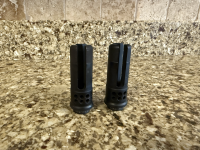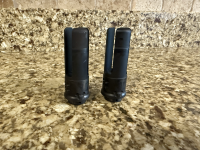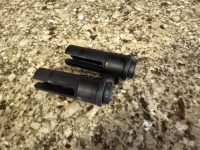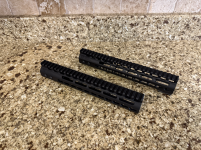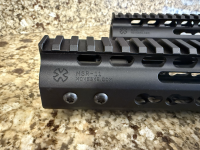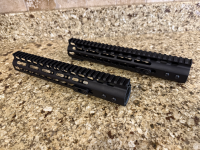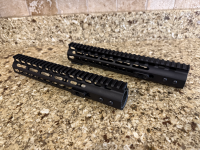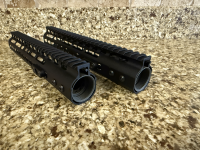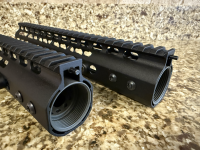Join the Hide community
Get access to live stream, lessons, the post exchange, and chat with other snipers.
Register
Download Gravity Ballistics
Get help to accurately calculate and scope your sniper rifle using real shooting data.

Install the app
How to install the app on iOS
Follow along with the video below to see how to install our site as a web app on your home screen.
Note: This feature may not be available in some browsers.
You are using an out of date browser. It may not display this or other websites correctly.
You should upgrade or use an alternative browser.
You should upgrade or use an alternative browser.
Latest activity
Filter
Filters
Show only:
Hunting & Fishing Post your SMK/Match bullet kills
- Sniper’s Hide Fieldcraft
- 440 Replies
I took this guy last week with a Hornady 140 BTHP from my 6.5 PRC. Shot was about 430 yards, through both lungs.


This is a first, Amish mom says cop was justified in smoking her boy.
- By Maser
- The Bear Pit
- 19 Replies
Imagine that , the Amish first claimed that it was police brutality, and he was a good boy , idiot probably felt 10 ft tall and bulletproof because he had a pistol , typical hood rat behavior.
They are very quickly becoming aware that they're no longer untouchable.
Barrel Torque Ludicrocity
- By MikeRTacOps
- Bolt Action Rifles
- 173 Replies
Remington 700's between 500 and 800@AccuSol-ERN - I got a beautiful BA from you a few years ago. Deviant and a Bartlein blank I sent you. What torque do you use on a barrel install?
@MikeRTacOps - yeah…not bc asking for your secret sauce, but do you torque your barrels to at least 100 ft/lbs or greater?
Thanks
Surgeon 591's min. 350
Any other custom actions 300 to 450
Red Ryder BB guns hand tight
Mike R
Barrel Torque Ludicrocity
- Bolt Action Rifles
- 173 Replies
Where are you seeing a screw?And patently wrong. The screw doesn't touch the barrel.
Accessories Surefire Warcomp Flash Hider (556 - 1/2-28) (Qty. 2)
- Buy - Sell - Trade
- 0 Replies
Up for sale are two Surefire Warcomp Flash Hiders threaded 1/2-28.
The assembly tool and some timing shims will be included with each flash hider.
These flash hiders are in great condition.
I can send additional pictures if necessary.
I'm asking $100 shipped for each flash hider.
The assembly tool and some timing shims will be included with each flash hider.
These flash hiders are in great condition.
I can send additional pictures if necessary.
I'm asking $100 shipped for each flash hider.
Attachments
Accessories 6mm GT Barrel for Sale (CRB)(Impact Action)
- By Danrobberg
- Buy - Sell - Trade
- 13 Replies
Impact barrels will fit in lone peak fuzions but barrels chambered for lone peak fuzions will not have the clearance for the bolt Face of an impact. The counterbore is about .010 longer on the impact barrels. Some smiths barrels may fit both but it is not a guarantee.
Barrel Torque Ludicrocity
- By bohem
- Bolt Action Rifles
- 173 Replies
I said it's not floating. Floating and flexing are different. The way you have it drawn the thread wedge can move forward and aft in the joint without any significant load applied. In the action the ears must flex through significant preload applied by the locking screw. That load is translated into joint preload on the entire joint. The important factor in that setup is the ears have the same thread position that the rest of the tenon has. This means that when the ear flexes inward the timing of the thread flank doesn't change initially but rather once the screw load is applied to fold the ear into the threads. As the ear comes into contact with the barrel threads it moves as the driving contact on the barrel male thread. The tighter you make the screw the more force it applies to the ear, the farther the ear's thread drives towards the barrel and those threads form a ramp that effectively closes the PD down on the joint.But it does flex, and is not rigid. There is clearance.
Since the joint is stationary against the shoulder plane the change in PD creates axial load due to the change in radial load. That axial load is the preload we're talking about being applied and acts just like torque to the joint.
All of this is because the ear does not move axially in the joint without significant load applied to it. It's not like a floating thread wedge like you might find in a locking ring on a Redding die body.
Barrel Torque Ludicrocity
- Bolt Action Rifles
- 173 Replies
Yeah, no shit. I missed where I depicted a set screw. Drawing was in its most simplistic form.Then no, your drawing is wrong. It’s not a set screw on the barrel. There’s slit in the action and the screw passes under the barrel, clamping the slit on the threads.
Accessories Parts clean out
- By Watch_this71
- Buy - Sell - Trade
- 10 Replies
Barrel Torque Ludicrocity
- By Supersubes
- Bolt Action Rifles
- 173 Replies
Most of the receiver is threaded normally(fixed), any squeeze by the clampc which is closing at the 6 oclock position, puts additional load on the already loaded flank. This is where the tensile load comes from. Its pulling the shoulder into the receiver face.The flank may be loaded by the torque of hand tightening, BUT mechanism in the AWMC does not increase the tension in the joint.
If you put pressure at the arrow onto the chingadera, will it increase the pressure beteeen the barrel shoulder and receiver face, decrease it, or stay the same?
View attachment 8787122
Accessories Noveske NSR-11 Keymod Handguard (Qty. 2)
- Buy - Sell - Trade
- 0 Replies
Up for sale are two Noveske NSR-11 Keymod Handguards.
These handguards are in excellent condition.
Each will come with a keymod quick detachable sling mount, and one will come with a short picatinny rail section.
I'm asking $125 shipped for each handguard.
I can provide additional pictures if necessary.
These handguards are in excellent condition.
Each will come with a keymod quick detachable sling mount, and one will come with a short picatinny rail section.
I'm asking $125 shipped for each handguard.
I can provide additional pictures if necessary.
Attachments
Barrel Torque Ludicrocity
- Bolt Action Rifles
- 173 Replies
Sorry, AXMC…Mind posting a link, or even a pic of something called an, “AWMC”?
Barrel Torque Ludicrocity
- Bolt Action Rifles
- 173 Replies
But it does flex, and is not rigid. There is clearance.The pressure at the shoulder increases. The wedge drives the barrel rearward and provides additional load into the shoulder.
The piece you're calling the chingadera isn't floating in the action. It's cut as a single unit to the receiver body and they have an H shaped cut that allows for the ears of the tab to flex. This means that the loaded flank continues to be the loaded flank and drive additional load into the shoulder face.
Barrel Torque Ludicrocity
- Bolt Action Rifles
- 173 Replies
That’s exactly what’s happening an an AWMC.That's not what's happening in the action. Your drawing is incorrect.
If not, I welcome your drawing.
Barrel Torque Ludicrocity
- By bohem
- Bolt Action Rifles
- 173 Replies
The pressure at the shoulder increases. The wedge drives the barrel rearward and provides additional load into the shoulder.The flank may be loaded by the torque of hand tightening, BUT mechanism in the AWMC does not increase the tension in the joint.
If you put pressure at the arrow onto the chingadera, will it increase the pressure beteeen the barrel shoulder and receiver face, decrease it, or stay the same?
View attachment 8787122
The piece you're calling the chingadera isn't floating in the action. It's cut as a single unit to the receiver body and they have an H shaped cut that allows for the ears of the tab to flex. This means that the loaded flank continues to be the loaded flank and drive additional load into the shoulder face.
Well, now I’m realizing I’m even older than when I realized I was old.
- By XTR
- The Bear Pit
- 15 Replies
I need to look deeper, I’m not sureWere those ticket prices directly though the venue or ticket scalpers.......I mean "brokers"?
Edit: stub hub is about 250 to thousands, but about 1/2 what I saw in the first site. This is all pre-sales
NEW- Limited Razor 1-6
- By davsco
- Observation & Sighting Devices
- 47 Replies
just bought this kit from eurooptic. very nice glass and definitely daylight-bright center dot. will go on a 14.5" that i may use occasionally in 2 & 3 gun. love my original non-e 1-6 with the jm-1 reticle on my primary 2/3 gun AR.
More lies revealed. Oil didn’t come from Dino bones 42 miles deep
- By earthquake
- The Bear Pit
- 68 Replies
Oil & gas is not made from dinosaur or any other vertebrate animal remains. It’s primarily comprised of phytoplankton and plant matter, pelagic ooze type stuff that has carpeted the oceans for hundreds of millions of years. Gets buried, compressed, trapped in rock. There is and never was enough biomass in dinosaurs for it. Now in the amount of microscopic sea and plant life…for sure there is plenty enough .
Yes, I’m a professional geologist of 21 years now.
O&G as we currently know and use from the CMB? No. Abiotic synthesis at CMB depths may produce some bound methane states like on Neptune etc due to massive pressures, but it’s not the same as in crude reservoirs at current exploitable depths. And you’d never get to it. It’s about 1,800 miles down. Deepest we’ve ever drilled is 12 miles. Good luck.
Yes, I’m a professional geologist of 21 years now.
O&G as we currently know and use from the CMB? No. Abiotic synthesis at CMB depths may produce some bound methane states like on Neptune etc due to massive pressures, but it’s not the same as in crude reservoirs at current exploitable depths. And you’d never get to it. It’s about 1,800 miles down. Deepest we’ve ever drilled is 12 miles. Good luck.
Load more
